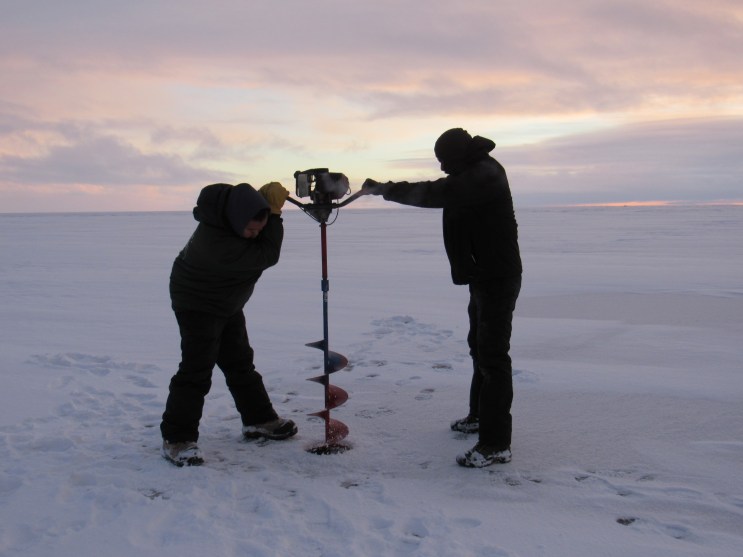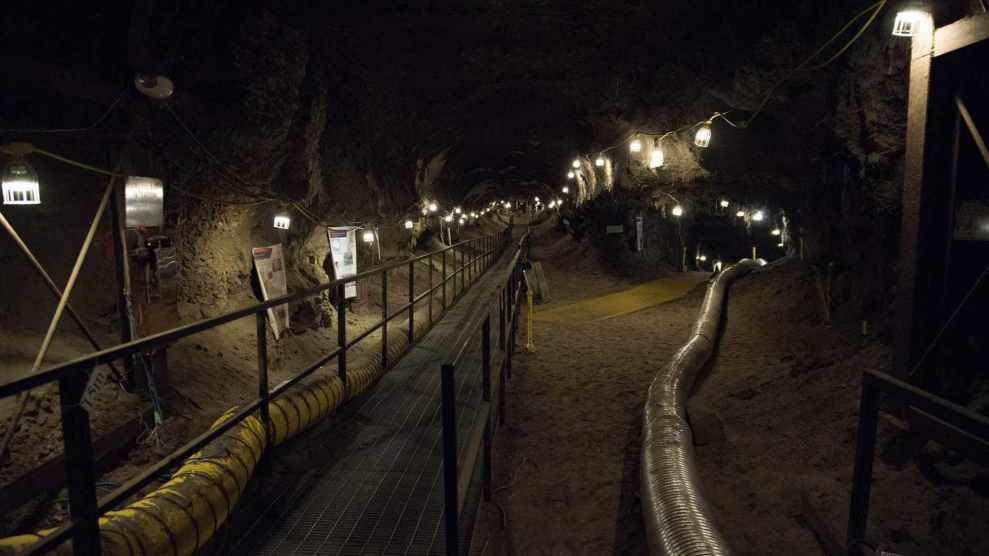
A metal boardwalk extends into the interior of the Fox tunnel. Whitney McLaren/Undark
This piece was originally published in Undark and appears here as part of our Climate Desk Partnership.
To enter the Fox permafrost tunnel—one of the only places in the world dedicated to the firsthand scientific study of the mix of dirt and ice that covers much of the planet’s far northern latitudes—you must don a hard-hat then walk into the side of a hill. The hill stands in the rural area of Fox, Alaska, 16 miles north of Fairbanks. The entrance is in a metal wall that’s like a partially dissected Quonset hut, or an enlarged hobbit hole. A tangle of skinny birches and black spruce adorn the top of the hill, and a giant refrigeration unit roars like a jet engine outside the door—to prevent the contents of the tunnel from warping or thawing.
On a mild, damp day in September, Thomas Douglas, a research chemist, escorts visitors through the tunnel door. Douglas works for a project of the US Army Corps of Engineers called the Cold Regions Research and Engineering Laboratory (CRREL), which has its fingers in everything from snowmelt modeling and wetlands plant inventories to research on stealth aircraft. But his own work focuses on several aspects of permafrost, and he leads occasional tours here.
Inside, the permafrost tunnel itself is even stranger than its exterior. A metal boardwalk crosses a floor thick with fine, loose, cocoa-colored dust. Fluorescent lights and electrical wires dangle above us. The walls are embedded with roots suspended in a masonry of ice and silt, with a significant content of old bacteria and never-rotted bits of plant and animal tissue. Because of this, the tunnel smells peculiar and fetid, like a malodorous cheese (think Stilton or Limburger) but with an earthy finish and notes of sweaty socks and horse manure.
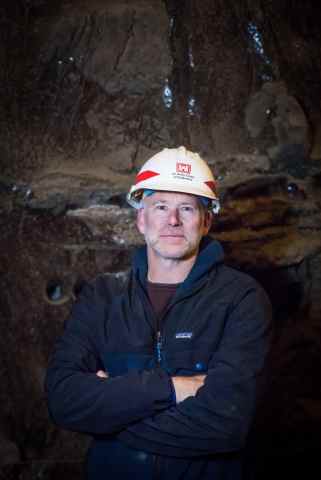
Thomas Douglas, a research chemist at the Cold Regions Research and Engineering Laboratory (CRREL).
Whitney McLaren / Undark
A trim person in a light jacket, Douglas strolls down the boardwalk with an amiable half-grin on his face, narrating the surroundings with the kind of glib enthusiasm of a museum docent or a mountain guide. “This part of the tunnel here is about 18,000 years old. We’ve had it carbon-14 dated. This is kind of a bone-rich area right here,” he says. He gestures to what look like gopher holes in the silt—the gaps left behind by cores drilled by science teams. The bone of a steppe bison, a large Arctic ungulate that went extinct about 10,000 years ago, at the end of the last Ice Age, rests in the hard peat. A little further along: a mammoth bone. We have stepped both underground and back in time.
The earthen walls look like they could be soft, like mud, but he raps the end of a long metal flashlight against one of them, and it makes a clinking sound. “You can see this is hard as a rock,” he says.
Permafrost is one the weirder concoctions of the Earth’s Ice Ages. In the abstract, it sounds like a simple substance—any earth material that stays frozen for two or more years. In reality, it is a shape-shifting material that underlies about 24 percent of land in the Northern Hemisphere—from the Tibetan Plateau to Siberia and parts of Arctic and sub-Arctic North America. Now many such areas are becoming both volatile and fragile. Permafrost can be hard as bedrock, but when it thaws, if it’s rich in ice and silt, it can morph into something like glue or chocolate milk or wet cement. In its frozen state, it can hoard materials for thousands of years without allowing them to decay. It can suspend bacteria in a kind of cryo-sleep—still alive for millennia.
Much of the scientific research on permafrost has been done from above or afar, via remote sensing equipment and computer models, or through happenstance in old mining tunnels or places where a river bluff has fallen apart and exposed millennia-old ice. Sometimes it’s done via the laborious process of hand-sampling and boring a hole deep into the ground. “Really most of us are studying permafrost from the surface, and we’re imagining what it looks like underneath,” says Kimberly Wickland, a US Geological Survey ecologist who studies carbon emissions from lakes and wetlands. The Fox tunnel is one of only two underground facilities dedicated exclusively to the scientific study of permafrost where a visitor can actually walk around inside the frozen earth. (The other is in Siberia.) When Wickland stepped into the tunnel for the first time in 2001, it was like a revelation she says—the moment she truly grasped what permafrost was.
Here, people like Wickland collaborate with Douglas, his colleagues, and researchers from all over the world. Collectively, they have studied everything from the utility of ground-penetrating radar in space exploration—the tunnel is thought to be an analog for Mars—to isotopes in steppe bison bones that might suggest something about the migration habits of these creatures before they went extinct. Here you can see the stuff in three dimensions, and easily retrieve 18,000 to 43,000-year-old specimens of it for research. You can reckon with how complex permafrost is, how much of it remains hidden, and how much scientists still need to learn. You can study and decode the vast amounts of information it potentially holds about the Earth’s history, and you can test the ways its disappearance might influence the planet’s future.

The semicircle-shaped entrance to the Fox tunnel (left), covered with birches and spruce.
Whitney McLaren / Undark
Indeed, permafrost is discussed most often these days in a global context and, increasingly, it is a subject of alarm. In December, the National Oceanic and Atmospheric Administration revealed that the world’s permafrost—which used to capture and store carbon—is instead collapsing and setting loose things that it had long ago entombed. Some scientists worry its thaw could liberate microbes wholly foreign to the modern world (a threat whose significance seems even more disturbing in light of the damage wrought by the Covid-19 pandemic). Meanwhile, the NOAA analysis suggests that the globe’s unraveling permafrost is already releasing as much as 300 to 600 million metric tons of planet-warming carbon into the atmosphere annually, about as much as the myriad industrial and transport activities of France or Canada. The finding is a warning signal—possibly the beginning of a feedback loop in which natural processes in the Arctic may make the impacts of climate change far worse.
As climate change warms soil temperatures across Alaska, too, the Fox tunnel probably contains some of the most protected and coldest permafrost in the area. How long that will remain true is hard to predict. A visitor to the tunnel can’t help but wonder just how much will ultimately be lost biologically, ecologically, and scientifically—as the planet’s permafrost collapses.
Early on, permafrost was mostly an engineer’s concern, and it was often a nuisance. Around Fairbanks in the early 20th century, permafrost was an obstacle lying between prospectors and the gold beneath. So miners would blast through or thaw it with devices called steam points, turning the frozen earth into muck, then haul it out to get to the gold. (The younger, front part of the hill in which the Fox Tunnel now stands was dredged and hauled away by gold miners, which is why the tunnel features mainly ancient permafrost.)
Elsewhere, permafrost was a construction problem. In 1942, when the U.S. Army Corps of Engineers sent more than 10,000 soldiers and civilians to carve the Alaska Highway through eastern Alaska and into Canada, engineers discovered that one could not build directly on top of the stuff without thawing it—a hard lesson that involved broken equipment and trucks stuck in unyielding mud. The construction challenges helped identify “cold regions research requirements” that would later lead to the formation of CRREL, according to a history published by the Corps.
Only in the Cold War did the frozen ground begin to seem like a possible asset, and a thing worthy of scientific inquiry. The Department of Defense wanted to see whether icy terrain could offer a secure location for military bases and operations. In 1959 and 1960, the US Army built what amounted to a city under the snow in Greenland, called Camp Century, with labs, a dormitory, a gymnasium, a barbershop, and a nuclear reactor to supply heat and power. Here, they studied the properties of snow and drilled to the bottom of the Greenland Ice Sheet for the first time. The camp was also intended to house “Project Iceworm,” which aimed to build thousands of miles of tunnel inside the ice sheet and use them for storing ballistic missiles and nuclear warheads. But after a few years, it became clear that Greenland glaciers were too dynamic and unstable to support such a network, and the project was canceled. The camp was abandoned in 1966.
The Fox permafrost tunnel had a more modest purpose. In 1963, when it was first dug, it was simply designed to test whether frozen ground could be an adequate bunker or smaller-scale military storage facility. Permafrost is naturally shock-absorbent and could theoretically handle shelling and bombing. George Swinzow, a geologist in the Experimental Engineering Division of CRREL, one of the first builders and stewards of the tunnel, had also attempted to create his own synthetic version of permafrost, called “permacrete,” which he used to build columns, bricks, and other underground supports and masonry inside another newly excavated tunnel near Camp Tuto in Greenland. (Swinzow would also later write a tome titled “On Winter Warfare,” about the technical problems of combat in cold places.)
In 1968 and 1969, the US Bureau of Mines borrowed the tunnel and tested some blasting and drilling techniques in a gently sloping side channel called a winze. At the end, the tunnel looked like a lopsided letter “V.” For the next two decades, the main research carried out here still focused on engineering—permafrost as a physical thing rather than a biological one, a substrate that would affect the construction of buildings and pipelines. The engineers soon discovered that permafrost would warp and bend as it approached about 30 degrees Fahrenheit (or -1 degrees Celsius). So CRREL installed the first refrigeration unit at the entrance and a set of fans to send the cold air back through the earthen passageways. The chiller now keeps the facility at about 25 degrees (or about -4 degrees Celsius).
After turning down the winze, the boardwalk ends, and Douglas instructs his visitors to “walk daintily,” or to “walk like ninjas.” The ceiling of the tunnel lowers, and he implores them to avoid kicking up the dust, also called loess—a type of delicate dirt carried miles by the wind and collected in this hill. When the tunnel was first dug, the ice held the loess in place. But when exposed to frigid air, ice will convert directly to water vapor, a process called sublimation. When the ice departed, it released the particles of dust onto the floor. Dig through the dust—as Fairbanks paleontologists sometimes do—and you can find ground squirrel bones, millennia-old leaves still tinged with green, ancient seeds and fruits, and beetle carapaces that look like they might have recently died on your windowsill.
By the early 2000s, the dusty surface of the tunnel also made it seem like a good analog for Mars, which has cold dirt and layers of its own permafrost. Researchers began running prototype rovers through the tunnel and using ground-penetrating radar to find novel ways to look for the water and ice—or even extraterrestrial life—on Mars. Around the same time, NASA became interested in whether ice-dwelling microbes might hold clues about the form and function of life on other planets. In 1999 and 2000, a NASA astrobiologist named Richard Hoover sampled microscopic filaments that he thought might belong to bacteria frozen into a 32,000-year-old section of the permafrost tunnel. In 2005, he announced his findings from those samples — the first species ever discovered to be still alive in ancient ice, an extremophile called Carnobacterium pleistocenium.

Thomas Douglas points to an image showing the layout of the Fox permafrost tunnel.
Whitney McLaren / Undark
The discovery heralded a new understanding of permafrost. It was proof that life could exist in extreme places. But more ominously, it suggested that the thawing happening all over the planet could awaken both ecological processes and long-dormant organisms, and not all of them might be benign.
Emerging from the winze, the permafrost tunnel opens into a high-ceilinged gallery of water-ice patterns, each one as beautiful as an abstract sculpture. This is the newer part of the tunnel, a section burrowed out between 2011 and 2018. The drilling here exposed these massive cross-sections of ice and earth, called “ice wedges.” Some are as wide as 15 feet across. (Unusually, some of the academic scientists at CRREL dug this part of the tunnel themselves, driving heavy machinery into the earth. Douglas was not involved, but snow researcher Matthew Sturm, who holds a post at the University of Alaska, Fairbanks, described driving a skid steer, like a small bulldozer, and a research engineer manned a device called a rotary cutter, attached to an excavator.)
Ice wedges are giant spears that form when water trickles into cracks in the silty parts of the permafrost. The new ice carves out gaps where water can percolate every summer season, so the wedges gather more ice and expand over time. Here, they spread across the walls in dark, glossy, marbled forms. “Isn’t this a wild shape? It reminds me of, like, a Da Vinci sketch,” exclaims Douglas. “Doesn’t it look like an eagle, like a man becoming an eagle?” He pauses before a sheet of ice that curiously resembles a figure—a head with pointed ears, arms spread like wings atop a glassy body, and feet shaped like tree roots. The formation is accidental, frozen in place here about 25,000 years ago, but such fantastical shapes abound. A few feet away from the eagle-man is a horizontal ice-tube that looks like a diorama, with grassy bits and roots and air bubbles suspended in it. This plant matter is around the same age but looks like someone picked it yesterday and stuck it inside a glass case.
The eagle-man and every ice formation in this gallery is a slice of a wedge. By capillary action, water can also collect into lenses and chunks in the soil. Some become enormous; some remain microscopic. Most of these bits of ice are about 99 percent frozen water, with little silt mixed in. But salts in the permafrost can lick the edges of the ice and form unfrozen bits. Here, in what are called brine channels, live other microbes. Today, these microbes are an increasingly active areas of study in the tunnel—and in permafrost research elsewhere in the world—for good reason.
In the popular imagination, microbes in permafrost are like tiny undead monsters—superbugs that waken and spread pandemics. In 2016, the Yamal Peninsula of Siberia had its first anthrax outbreak in 75 years, likely triggered when a heatwave thawed the region’s permafrost and released anthrax spores from a long-dead reindeer carcass. At least 20 people were infected, and one 12-year-old boy died. Such risks have given scientists enough pause that, in November, an international group in gathered in Hanover, Germany to discuss them.
And microbes may have an even more disturbing role in shaping the fate of the atmosphere: It is the microbes that will determine how much of the permafrost’s carbon escapes into the air and how much can be stored again in the dirt. In 2013, Wickland and a group of her collaborators came to the tunnel to gather bits of 35,000-year-old permafrost that had been carved out of the walls during the recent excavation. They collected these scrapings in several coolers packed with dry ice then flew with them to their laboratory in Colorado. They suspended the samples in water, then strained them, like tea, and measured how much carbon dioxide leached from the water.
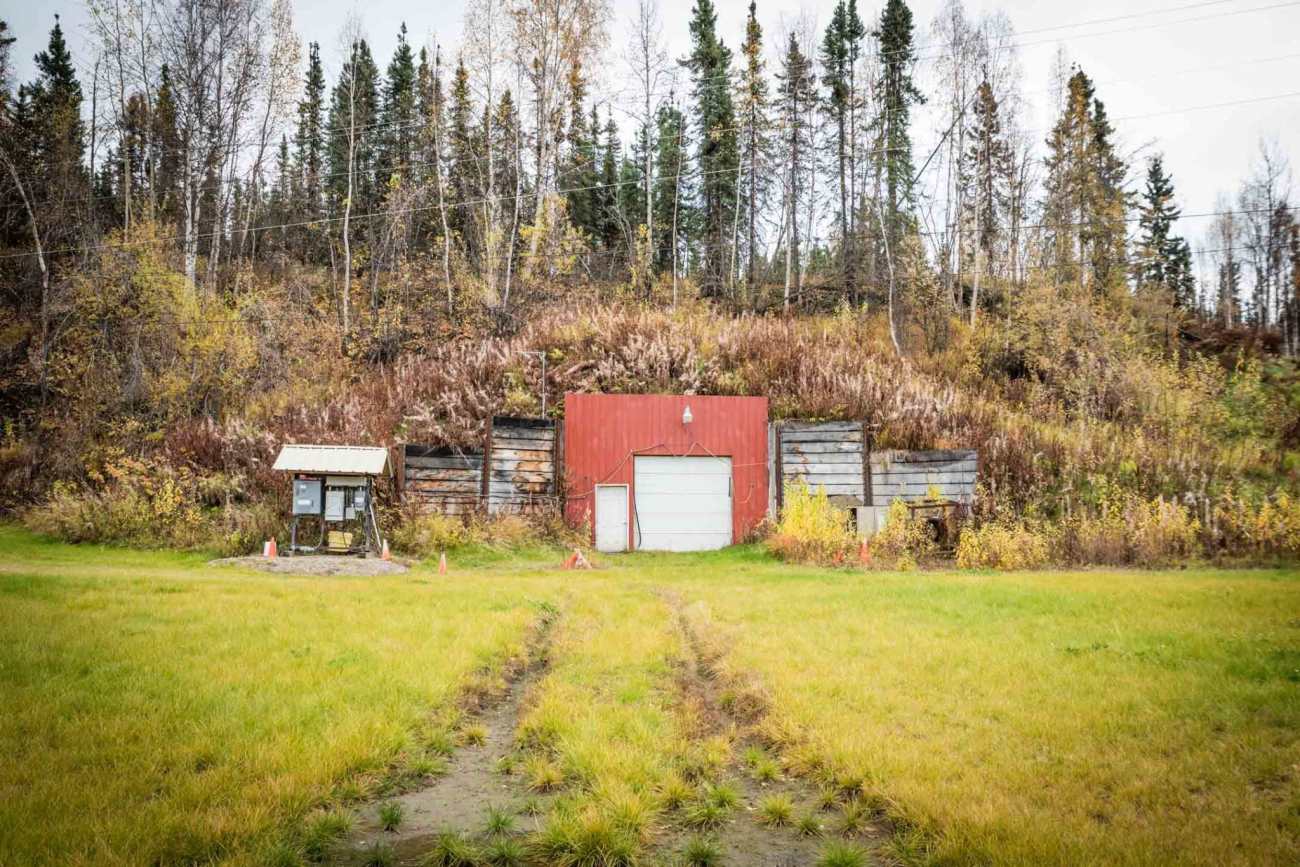
The second entrance to the Fox tunnel, installed in 2011.
Whitney McLaren / Undark
The thawed, awakened bacteria in the tea began breaking down the organic carbon in the sample; in less than a week, about half of it was emitted into the air as carbon dioxide. It was a disturbing finding. Scientists had long debated how quickly or gradually the thawing of permafrost would affect the global climate. But this study suggested the warming of ancient soils could produce a giant burst of emissions into the atmosphere in a short period of time—one more reason to be wary of the stuff.
But there are other scientists who are trying to find redeeming value in the newly awakened microbial community. Some have continued Hoover’s work, but brought more powerful DNA analysis into the search for live microbes in ice that might yield insights about interplanetary life. Robyn Barbato, a soil microbiologist at the CRREL lab in New Hampshire, also has plans to gather samples from the tunnel for the purpose of bioprospecting. This is the term used to describe the search for microbes that might help with the design of things like super-cold glue, bio-bricks, sustainable road materials, and antifreeze. “I consider the Far North and the Far South to be kind of the new Amazon. There’s all this biodiversity,” Barbato says. “We could really encounter interesting and useful processes that we can adapt to make things more sustainable.”
At least three times in the past 27 years, flooding from a combination of engineering troubles and heavy spring and summer rains has threatened the tunnel. In 1993, the floodwaters collected at the rear of the old tunnel, warped the ceiling, and brought down large chunks of silt. In 2014, water flowed into the tunnel from a nearby hillslope, and frozen puddles collected inside. In 2016, “we nearly lost the tunnel,” recalls Sturm. The rains altered the drainage above, and water infiltrated an ice wedge adjacent to the tunnel. “By the time anything could get done, it had eroded a house-sized piece of ice wedge.” The main pulse of the floodwaters ultimately drained away from the tunnel, but the close call reminded CRREL staff of the potential for catastrophe. Patches of ice from the various floods still linger in the tunnel.
“To me, that’s one of the most salient things we learned from the tunnel,” Sturm says. When permafrost collapses or erodes, the landscape left behind is called thermokarst. The word evokes limestone karst—a type of belowground terrain that is like Swiss cheese, full of caves, rock pools, springs, and streams formed by dissolving and eroding limestone. But thermokarst is far more unstable than limestone karst. Within a few years, a puddle left by permafrost thaw can turn into a lake, then collapse into a ravine. Permafrost won’t decay because of warm temperatures alone. Water will play a destructive role. Fires have also raged in recent years across Alaska and Siberia. Inside the tunnel, near a second entrance, is a thin black band along the wall, a line of charcoal from what was probably a fire. In the Anthropocene climate, if flames laid bare the hillside above the tunnel, heat might radiate into the ice inside and help thaw it.
Douglas leads the group out this second door and past another loud cooling fan into the damp air and daylight. He walks up the hill onto what is effectively the tunnel’s roof and then into the forest behind it, following an old footpath behind a fence through clusters of dwarf birches, willows, black spruce, and fragrant Labrador tea. It is a picture of collapsing permafrost and another active area of research. CRREL researchers have set up various meters and cameras to track snowfall and melt throughout the forest. His tour crosses several areas of sunken, flooded ground, and then a long gully with spruce trees curved toward it, as if they are bowing. Tea-colored water trickles through the center. This is the top of a collapsed ice wedge.
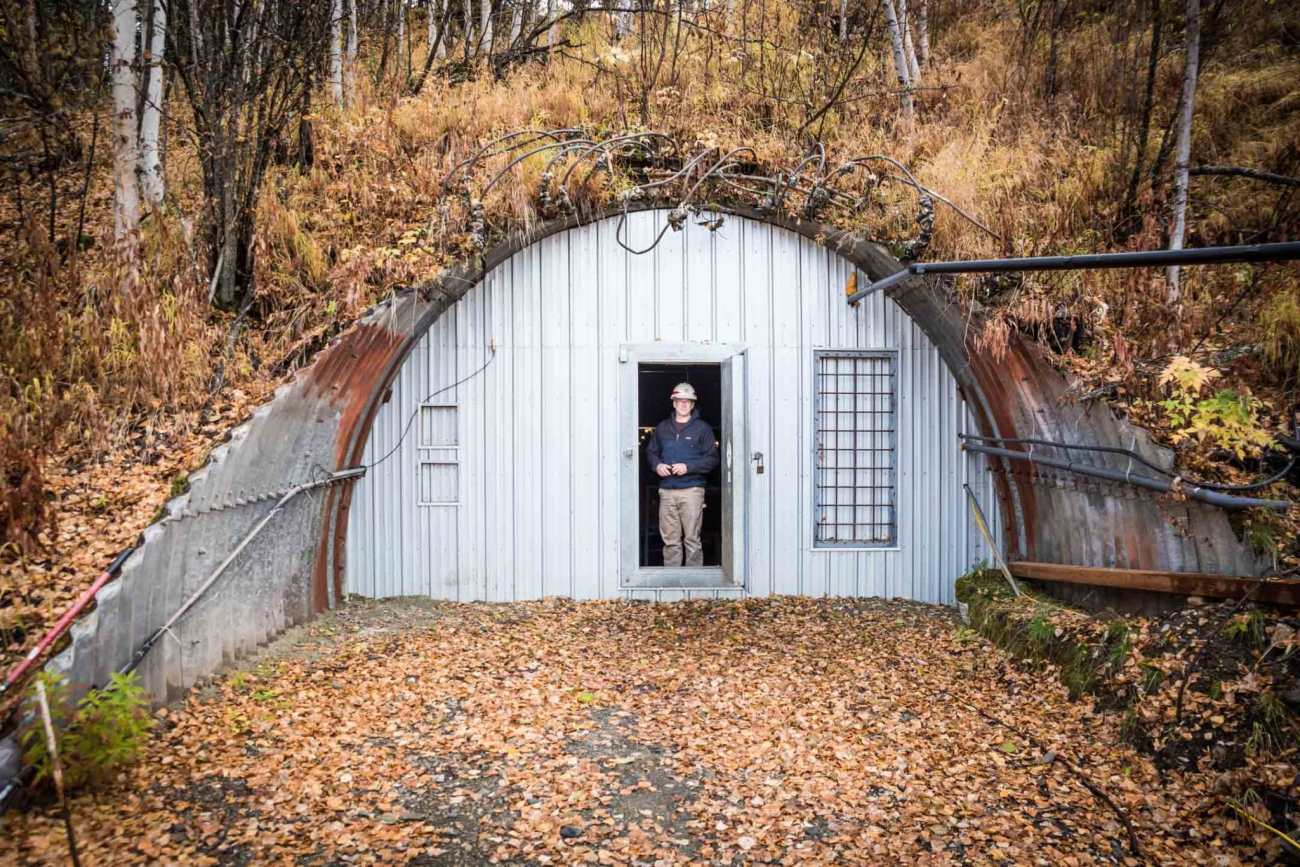
Research chemist Thomas Douglas stands at the entrance to the Fox tunnel.
Whitney McLaren / Undark
“Who knows how far out that ice wedge has melted?” Douglas says. “There is this sense that the underground is not stable.”
That sense of collapse extends far beyond here. The mean temperature of Fairbanks over the entire 2019 year was 32.6 degrees Fahrenheit, i.e., just above freezing, and permafrost cannot survive many more years like it. What lies inside the tunnel seems more and more like a captive, rare animal, an Earth form that might soon be lost. In a time of climate change, the Fox tunnel becomes a project for reckoning, on a grand scale, with that loss and its cascading effects. “Sometimes we’ll kind of joke about, at one point, we’ll have the only permafrost in the Fairbanks area,” Douglas says. This year, he and his colleagues will experiment with other means to extend the tunnel’s longevity, such as by using solar panels to power its chillers. They will complete an expansion project begun this winter by the end of 2021, doubling the size of the tunnel. This will allow them to see permafrost from many angles above (with radar) and below (with the human eye) and develop means to scan frozen ground on a large scale.
At its essence, it’s an effort to study and visualize the remaking of large parts of the Earth.
In the next 80 years, in just one lifetime, most of Alaska’s near-surface permafrost will fall apart, Douglas explains. “That will fundamentally alter hydrology, vegetation, the snowpack, the timing of spring melt, heat exchange, habitats for animals, and it’ll basically completely change the landscape.” The work ahead at Fox, he adds, is to understand the staggering ramifications of this loss. Alaska and all of the far North, he says, are “just going to be a fundamentally different place.”

